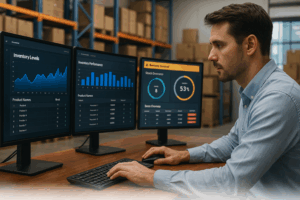Imagine a transportation system that propels freight at nearly the speed of sound through sealed vacuum tubes, bypassing traditional road and rail congestion, slashing carbon emissions, and enabling same-day delivery across continents. This is the promise of Hyperloop technology, a futuristic concept that’s rapidly evolving from theoretical vision to near-term reality. As global freight demands rise—with the volume of goods transported projected to increase by 50% by 2050—innovative, sustainable, and ultra-efficient transport solutions are becoming critical. Hyperloop is emerging as one of the most revolutionary contenders.
The Hyperloop Vision
First proposed by Elon Musk in 2013 through a whitepaper titled Hyperloop Alpha, the concept described autonomous pods traveling through low-pressure tubes at speeds up to 700 mph (1,127 km/h). In a near-vacuum environment, these pods would face negligible air resistance and friction, enabling energy-efficient, high-speed travel. Although originally conceptualized for passengers, the freight logistics industry has quickly recognized Hyperloop’s potential to transform cargo delivery across regional and international corridors.
The promise of Hyperloop lies not only in its speed but also in its potential for automation and operational control. Unlike traditional trucking routes, Hyperloop travel is insulated from weather, traffic, and human error, which results in a system that could offer both safety and reliability. Additionally, Hyperloop pods can be autonomously scheduled and spaced with precision, meaning they can run continuously without the delays associated with traditional freight handoffs or regulatory limitations on driver hours. This could significantly enhance the uptime and predictability of freight movements.
Unprecedented Speed
Hyperloop’s projected top speed of 700 mph dramatically surpasses that of conventional freight trains, which average 30–50 mph, and long-haul trucks, which average about 60 mph. Air freight is faster but limited by air traffic control, airport scheduling, and customs processes, not to mention its high cost and environmental impact. Hyperloop, by contrast, offers near-airplane speeds without the takeoff, landing, and fuel costs. A shipping container moving from Chicago to Atlanta, for example, could arrive in just over an hour—compared to 10–12 hours by truck.
This speed advantage doesn’t only impact long-haul freight. Hyperloop could revolutionize regional logistics hubs by enabling same-day delivery between cities hundreds of miles apart. For sectors like pharmaceuticals, electronics, and perishable goods, the ability to dramatically reduce time in transit while avoiding degradation or spoilage represents a significant economic advantage. As global supply chains become increasingly time-sensitive, Hyperloop’s potential to meet “next-hour” or “next-shift” delivery demands positions it as a transformational force.
Efficiency and Just-in-Time Delivery
Just-in-Time (JIT) delivery is a cornerstone of modern manufacturing and retail supply chains. Yet its success depends heavily on precise timing and limited inventory buffers. Hyperloop could help eliminate common bottlenecks by reducing exposure to traffic delays, fuel shortages, labor strikes, or adverse weather—issues that often disrupt truck-based JIT operations. By maintaining a consistent and rapid flow of goods, companies can minimize their reliance on safety stock, lower storage costs, and shrink their warehouse footprint.
Moreover, Hyperloop could support more agile supply chains by enabling dynamic inventory positioning. Retailers and manufacturers could shift from centralized mega-warehouses to decentralized micro-fulfillment centers connected by high-speed links. For instance, a distribution center outside of Dallas could replenish stores in Houston, Austin, and San Antonio multiple times per day. This kind of agility would be particularly beneficial for industries like fashion and consumer electronics, where rapid shifts in demand and seasonality require a flexible logistics model.
Reduced Congestion and Infrastructure Relief
Congestion on highways and rail corridors remains one of the most significant challenges to freight efficiency. According to the American Transportation Research Institute, trucks spend nearly 20% of their driving time in traffic congestion, leading to increased fuel consumption, driver fatigue, and delivery delays. Hyperloop, with its dedicated infrastructure, offers a bypass to these constraints—creating a parallel freight ecosystem with zero interference from passenger vehicles or traditional freight lines.
In addition to reducing congestion, the deployment of Hyperloop would alleviate wear and tear on roads and bridges. Heavy trucks are responsible for a disproportionate amount of damage to public infrastructure. By diverting a portion of freight to Hyperloop tubes, municipalities could extend the lifespan of roadways and reduce maintenance costs. This would represent billions of dollars in long-term savings for taxpayers, especially in freight-heavy corridors such as the Northeast I-95 or California’s Central Valley.
Environmental Sustainability
Transportation is the single largest source of greenhouse gas emissions in the United States, contributing over 28% of total emissions, with freight playing a significant role. Hyperloop’s ability to operate on electricity—and potentially from renewable sources like solar or wind—positions it as a viable solution for freight decarbonization. Unlike diesel trucks, which emit roughly 161.8 grams of CO₂ per ton-kilometer, Hyperloop could cut emissions to under 10 grams per ton-kilometer, depending on energy sourcing and efficiency.
Environmental sustainability is not just about emissions—it’s also about land use, noise pollution, and ecosystem disruption. Hyperloop tubes can be elevated or tunneled, minimizing the surface footprint and avoiding wildlife habitats, farmland, or urban congestion. Furthermore, Hyperloop pods produce minimal noise, especially compared to aircraft or diesel engines, making them suitable for urban and semi-urban environments where noise ordinances are strict. This makes Hyperloop uniquely positioned to meet the dual demands of logistics growth and environmental responsibility.
Enhanced Global Connectivity
Hyperloop’s modular and scalable nature could allow countries to build freight corridors that link major ports, airports, and inland logistics hubs. For instance, a Hyperloop route connecting Rotterdam Port to Berlin via Amsterdam and Hanover could turn a 10-hour truck journey into a 90-minute pod shipment. This kind of connectivity would not only increase throughput at international trade hubs but also enable landlocked countries and remote areas to integrate into global supply chains more efficiently.
Hyperloop could also play a critical role in international trade competitiveness. With the growth of e-commerce and customer demand for rapid delivery, nations that invest in high-speed freight infrastructure could gain a strategic advantage. For example, a country with Hyperloop-connected airports and ports might attract more logistics investment, become a preferred transshipment hub, or accelerate exports. This kind of infrastructure could rewire global trade routes—similar to how the Panama Canal and transcontinental railroads once did.
Challenges and Considerations
While the vision is compelling, real-world implementation of Hyperloop technology is filled with complexity. One of the largest challenges lies in infrastructure development. Each kilometer of tube must be precisely engineered to maintain vacuum integrity, withstand environmental stressors, and accommodate long-term maintenance. Tunnel boring for underground systems presents its own cost and engineering hurdles, while elevated systems require land acquisition and structural supports that can handle seismic activity and wind shear.
From a financial perspective, funding Hyperloop systems remains a major obstacle. With per-mile costs ranging from $20 to $60 million depending on geography, a regional route can quickly reach into the billions. For comparison, the California High-Speed Rail project—still under construction—has ballooned to over $100 billion for just 500 miles. To attract investment, Hyperloop companies must prove a viable revenue model, often through freight partnerships or state subsidies. Without clear commercial returns, governments and private investors may hesitate to commit capital at scale.
On the regulatory front, governments have yet to establish a global or national safety framework for vacuum tube transportation. Agencies like the U.S. Department of Transportation and the European Commission are beginning to draft standards, but questions remain regarding emergency protocols, interoperability, insurance liability, and oversight bodies. Achieving international consensus will be key for cross-border corridors, especially in regions like the EU or Southeast Asia where trade zones are integrated.
Finally, there’s the challenge of technology validation. While pod tests have demonstrated basic feasibility, scaling to multi-kilometer systems that handle full cargo loads at high speeds requires years of prototyping and rigorous validation. Questions around wear and tear on vacuum seals, track alignment under heat expansion, and real-time cargo loading remain unanswered. Interfacing with existing container sizes and transportation IT systems will also be crucial for seamless adoption.
The Future of Freight Transportation
Despite the challenges, Hyperloop’s transformative potential is undeniable. As climate change, urbanization, and globalized trade intensify pressure on traditional freight networks, the demand for a faster, cleaner, and smarter alternative will grow. Hyperloop offers a leap beyond incremental improvements—reimagining what’s possible in a world where distance becomes irrelevant and logistics becomes instantaneous.
The coming decade may see Hyperloop freight pilot programs implemented on key high-volume corridors, especially where rail and road systems are under the most strain. Early adopters are likely to be countries with strong political will, technological capabilities, and capital investment—such as the U.S., UAE, India, and the Netherlands. These pilots could demonstrate proof-of-concept, refine business models, and unlock funding for regional expansion.
Ultimately, the future of freight won’t be dominated by a single mode, but by smart integration. Hyperloop could serve as the high-speed backbone, supported by drones for last-mile delivery, trucks for flexible routing, and AI to orchestrate it all. In that future, freight would no longer be a bottleneck—it would be a strategic advantage.
About Us
The Perfect Planner Team specializes in supply chain innovation, freight optimization, and inventory automation. If you have questions about the future of freight transportation—or want to explore how your business can stay ahead of the curve—contact us for a free consultation at info@perfectplanner.io, visit our website at www.perfectplanner.io, or call 423.458.2979.
Author: Ed Danielov
Publication Date: May 8, 2025
© Copyright 2025 Perfect Planner LLC. All rights reserved.
References
- Statista (2023). Global Logistics Market Size 2020–2030. https://www.statista.com/outlook/tmo/logistics/worldwide
- Deloitte (2022). Global Supply Chain Survey Report. https://www2.deloitte.com/uk/en/pages/consulting/articles/supply-chain-insights.html
- U.S. Department of Transportation (2019). Freight Facts and Figures. https://ops.fhwa.dot.gov/freight/freight_analysis/faf/index.htm
- Zeleros (2021). Sustainable Transportation Emissions Comparison. https://zeleros.com/news/sustainable-transportation-emissions-comparison/
- Forbes (2022). Why the Hyperloop Costs So Much. https://www.forbes.com/sites/davidrvetter/2022/06/28/the-real-reason-hyperloop-is-still-a-dream-cost/
- Virgin Hyperloop (2020). Test Run Press Release. https://virginhyperloop.com/press/virgin-hyperloop-makes-history-as-first-company-to-successfully-test-hyperloop-with-passengers
- eMarketer (2024). Global E-Commerce Forecast. https://www.insiderintelligence.com/content/global-ecommerce-forecast-2024
- European Commission – Transport Homepage. https://transport.ec.europa.eu/index_en
- HyperloopTT (2023). Cargo Solutions White Paper. https://hyperlooptt.com/media/pages/technology/hyperloop-freight-transport/






